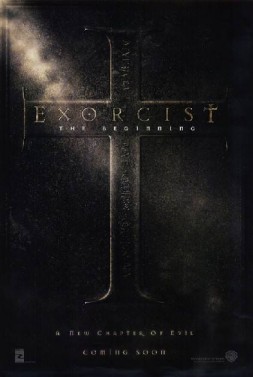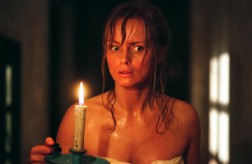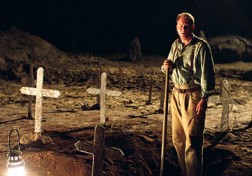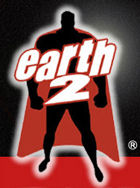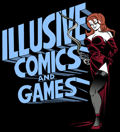Exorcist:
The Beginning
When
you hear those Tubular Bells, you know that evil lurks in
the shadows. The skin on the back of your neck starts tingling,
and you say a quick prayer of thanks that you skipped the
split pea soup for lunch. But neither that sensation nor
the bells carry over to Exorcist: The Beginning,
the fourth film in a franchise that you may have completely
forgotten was a franchise, even though the trailer worked
very hard to remind you.
Actually, Renny
Harlin's directorial job marks the fourth and a half film.
Writer/director Paul Schrader took a whack at it first,
but Warner Brothers turned it down for reasons of commercial
viability. Then they hired Harlin to use the same plot elements
and reshoot the entire thing with that special Harlin touch,
which means bigger, louder and wherever possible, just a
skosh incoherent.
They certainly
got it. But it's tacked on to a story idea that seems much
more meditative. Thus, the film frays at the edges, tugging
between the question of man's own capacity for evil and
the efforts of the devil himself, so that we can have vomit,
guts and things blowing up good.
Technically,
it's not the devil himself. Though the film never mentions
it by name, the stone idols that dot a sunken cathedral
are of a demon called Pazuzu, a factoid revealed in Exorcist
II: We Should Have Just Let It Stand At One. So the
screenwriters (credited to Alexi Hawley, from a story by
William Wisher and Caleb Carr) are stuck with little bits
of trivia from the earlier films while still accommodating
what people think they know about the franchise.
As a result,
the baby-faced Father Francis (James D'arcy) spends a lot
of time talking about Lucifer, when really it's one of his
underlings making all the natives restless. He makes the
audience restless, too, by having possessed Harlin to poorly
imitate Schrader's work without having a sense of why.
Wasting cinematographer
Vittorio Storaro, Harlin plays around with monochromatic
shots whenever possible. They come off as cheap shots. Bathing
Izabella Scorupco in sickly green lighting serves to force
the audience to feel suspense without knowing why, and it
fails to pay off. Long segments roll by in khaki, with even
Scorupco and Stellan Skarsgard fading into the scenery.
Harlin also has a strange fixation with close-ups, cut badly,
which causes them to lose their impact as a story-telling
device. More likely, he's covering up a lack of chemistry
between Scorupco and Skarsgard. It all ends up just looking
drab instead of, perhaps, thoughtful and reflective.
The pieces are
there. Set just a couple of years after World War II, the
film recasts Father Lancaster Merrin (Skarsgard, in the
role originated by Max Von Sydow) as Indiana Jones, but
without any of the excitement. His faith tested and destroyed
by the Nazi occupation, Merrin has defrocked himself, boozing
it up and claiming a vague role as an archaeologist. The
mysterious Semelier (Ben Cross) enlists him to join a dig
in Kenya in order to retrieve an artifact, a totem of the
demon we know as Pazuzu.
While Merrin
suffers flashbacks to the terrible moment when he lost his
faith, he struggles to find out just why this Kenyan dig
has the natives so spooked. Well, he doesn't so much struggle
as stumble into his answers, with lots of little portents
that nobody seems willing to put into the big picture. Even
Father Francis' disturbing problem of having his crucifix
turn itself upside down never warrants a mention to anyone
else.
Sure, Pazuzu
lurks on the edges, dropping signs and wonders, mostly bloody,
without ever once doing something in a floral arrangement
so that reviewers could make a joke about Pazuzu's petals.
Such are demons.
In the last
third of the film, Harlin finally finds his footing and
gets things raring, but it's too little, too late. A long-promised
slaughter occurs, but shot through smoke and darkness, so
there's not enough coherent action to satisfy those who
want it. Script-wise, though Pazuzu's revelation perks up
interest, it's also clear that a character spent a lot of
time in torment for no other reason than to throw us
off the trail of what was supposedly going on. Hand in hand
with that pointless torment is the fact that several characters
could have pointed out something pretty major to Merrin,
but chose not to for no reason other than it would wreck
the reveal. That annoyance almost completely outweighs the
pleasure of seeing an old-fashioned demonic throwdown.
At least in
that throwdown, Skarsgard betrays an emotion besides vague
annoyance at having had to film the movie twice. Harlin
has proven himself a muscular director in films that don't
have much emotional weight, and so maybe the actors simply
didn't get direction. There's no through-line here, no arc,
and no sense of how shattering it must be for someone who's
lost his faith to rediscover it because of an exposure to
ultimate evil. Merrin is just as grim at the end as he is
in the beginning, but more likely sober.
So,
too, will audiences be.
Note:
Schrader's version still exists, and will be released on
home video either as part of a 2-disc set with Harlin's
film, or as an alternative. Truly, I am fascinated to see
it.
Rating:

|
